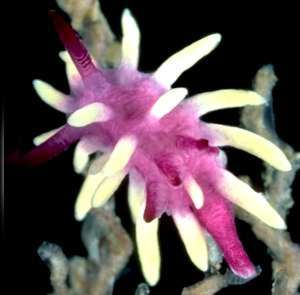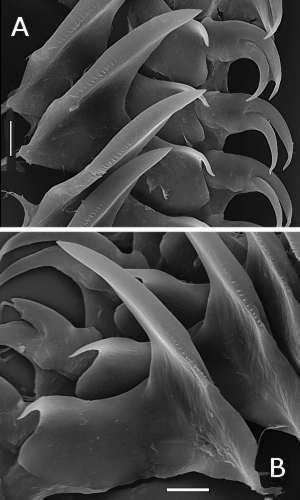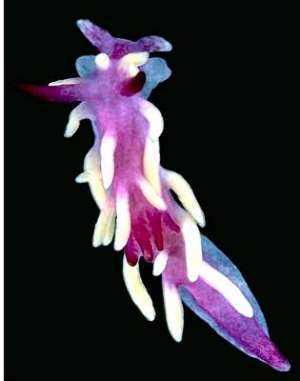
Okenia purpurata
Rudman, 2004
Order: NUDIBRANCHIA
Suborder: DORIDINA
Superfamily: ANADORIDOIDEA
Family: Goniodorididae
DISTRIBUTION
Previously known only from northern New South Wales, eastern Australia. But Toh Chay Hoon's record from Singapore [#22383 ] suggests a wider Indo-West Pacific range.
PHOTO
Upper Right: Split Solitary Is, Coffs Harbour, New South Wales, Australia, on bryozoan, Amathia tortuosa, December 1990, 9 mm long, AM C164523. Photo: W.B. Rudman. Lower Left: SEM of radula. A, part of right side. B, part of left side. Pig Is., Coffs Harbour, New South Wales, Australia, 8 December 1990, AM C164605. Scale bars = 10 µm. Photo: A.C. Miller. Lower Right: Split Solitary Is, Coffs Harbour, New South Wales, Australia, December 1990, 9 mm long, AM C164523. Photo: Bill Rudman.
The body is elongate with a distinct mantle edge bearing 7 cerata-like papillae on each side, which range in length from the relatively short anterior pair to the 4 posterior pairs which are long and cylindrical, tapering to a rounded tip. There is a single mediodorsal papilla about midway between the head and the gills, and a group of 3 or 4 papillae arranged in a transverse line just in front of the gills. In some specimens there is also a small median papilla just behind the gills. There are 4 or 5 long, simple gills. The head bears a pair of rounded and flattened oral tentacles. It grows to at least 11mm long alive. Background colour is pinkish purple, deepening on the rhinophores and gills to a deep reddish purple. The tip of the posterior end of the foot is also deeper in colour. The rounded oral tentacles are a uniform purple. The lateral papillae around the mantle edge are a creamy white or yellow, except for the anterior pair which are a watery purple with a creamy white or yellow tip. The head, foot and sides of body are purple except for a broad translucent cream band at the edge of the foot.
The radula is fairly typical for the Goniodorididae. The innermost tooth has a broad base and a long elongate pointed cusp. At the base of the cusp there are a few [5-6] very small remnant denticles. The innermost tooth also has a large pointed spine arising from the upper inside corner of the base of the tooth. The much smaller outer teeth have a broad quadrangular base with two very large, slightly recurved, pointed cusps
This species has a very distinctive colour pattern. It is very similar in external shape to Okenia vena, and both can be found on the same bryozoan colony. However the colour pattern of the two species is quite different with Okenia purpurata having a purple body and white papillae, while Okenia vena is white all over, with a pattern of brown veins over the dorsal surface. It is usually found on the ctenostome bryozoan Amathia tortuosa Tenison Woods, 1880.
-
Rudman, W.B. (2004) Further species of the opisthobranch genus Okenia (Nudibranchia: Goniodorididae) from the Indo-West Pacific. Zootaxa, 695: 1-70.


Rudman, W.B., 2004 (December 21) Okenia purpurata Rudman, 2004. [In] Sea Slug Forum. Australian Museum, Sydney. Available from http://www.seaslugforum.net/factsheet/okenpurpurat
Related messages
-
Re: Okenia purpurata from Singapore with 3 gills?
From: Ivan Choong, April 6, 2009 -
Re: Okenia purpurata from Singapore with 3 gills?
From: Toh Chay Hoon, April 3, 2009 -
Okenia purpurata from Singapore
From: Toh Chay Hoon, April 2, 2009 -
A pair of Okenia purpurata
From: Leanne & David Atkinson, January 23, 2007 -
Okenia purpurata from New South Wales
From: Leanne & David Atkinson, January 18, 2007 -
Okenia purpurata - new record
From: L. & D. Atkinson, February 20, 2006
